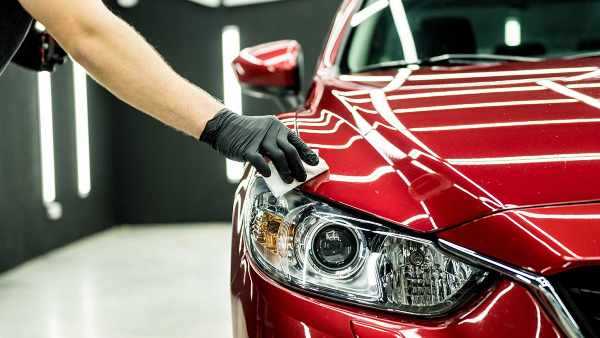The benefits of ceramic coating transcend beyond surface aesthetics, providing durable and robust protection in different climate conditions.

Cold Climates
In colder climates, ceramic coating offers unmatched protection against road salt, slush, and ice. The coating’s hydrophobic properties repel water, reducing the risk of ice accumulation and rust formation. The nano-ceramic shell also provides resistance to chemical corrosion presented by deicing substances frequently used on roads.
Hot Climates
Hot climates amplify the damaging effects of UV rays. Ceramic coatings, however, shield your automobile, acting as a sunscreen by effectively dispersing these harmful rays and reducing oxidation and paint fade. Also, micro-dirt and dust from the hot and often dry climates can’t adhere as quickly on a ceramic-coated surface.
Coastal Climates
Coastal regions come with the menace of saltwater and humidity that instigate metal corrosion. Our expert, Timur recommends ceramic coating from Gleamworks Detailing for its superb anti-corrosive properties suitable for these conditions.
Desert Climates
Ceramic coating is perhaps your vehicle’s best ally in desert climates. The sturdy nano-coating ensures sand scratch resistance, safeguarding the car’s clear coat. The brilliant heat resistance also protects the paint from extreme desert temperatures.
The Benefits of PPF in Different Climates
Paint Protection Film (PPF) offers robust defense against various climate-induced damage, ensuring your car maintains its gleam regardless of where you are.
Cold Climates
In wintry regions, PPF protects against road salt and ice, reducing chances of paint chipping. It also enables easy cleaning of snow and slush.
Hot Climates
In hot climates, PPF reflects UV radiation, diminishing paint oxidation. It also prevents minor scratches and dings caused by debris in windy and dry conditions.
Coastal Climates
The persistent humidity and salty sea air pose threats to your vehicle’s exterior. But, equipped with PPF, your vehicle’s paint job will resist saltwater corrosion effectively.
Desert Climates
For desert conditions, PPF is beneficial due to its dust and scratch-resistant properties. It shields the car from sand abrasions and heat damage.
A Comparative Analysis: Ceramic Coating Vs. PPF for Different Climates
While both Ceramic Coating and PPF offer substantial protection against severe climatic conditions, selecting one over the other depends on your specific need and environment. Ceramic coating offers unparalleled shine and minimizes dirt accumulation. PPF, on the other hand, provides more physical protection against scratches and chips.
Why You Should Consider Ceramic Coating or PPF for Your Vehicle
If you value your car’s aesthetics and longevity, it’s essential to consider Ceramic coating or PPF for ultimate protection. Besides the practical capability of preserving your vehicle`s paint, these applications enhance your car’s appeal, making every drive feel like a journey in a new car. Trust in expert services, like the ones offered by Gleamworks Detailing to help you make an informed decision.
Understanding Ceramic Coating and PPF: What are they?
When it comes to vehicle protection, Ceramic Coating and PPF (Paint Protection Film) are two leading options. But what exactly are they? Ceramic Coating for cars is a liquid polymer that bonds with the vehicle’s paint, providing a layer of protection. This coating is resistant to water, dirt, and even UV rays, making it a durable option for long-term vehicle care.
On the other hand, PPF for vehicles is a thin, clear film applied to the surface of the car. It serves as a physical barrier against scratches, rock chips, and even minor road debris. PPF is also self-healing; minor scratches can disappear with heat exposure.
Why Ceramic Coating and PPF: The Overall Benefits
Both Ceramic Coating and PPF offer numerous benefits. They provide a high level of protection against external damage, enhance the vehicle’s appearance, and improve resale value. Additionally, these protective measures make cleaning easier, as dirt and grime have a harder time sticking to the surfaces.
An Overview of Different Types of Climates: How Climate Affects Your Vehicle
Climate plays a significant role in the wear and tear of your vehicle. Harsh sun, heavy snow, high humidity, and salty air can all cause damage over time. Understanding how these climate elements affect your vehicle can help you make informed decisions about protective measures like Ceramic Coating and PPF.
Breakdown of Climate Types & Their Impact: Consideration for Ceramic Coating and PPF
Cold Climates
In cold climates, vehicles are often exposed to snow, ice, and road salt. These can cause corrosion and paint damage. Ceramic Coating and PPF can protect against these elements, repelling water and salt, and preventing rust formation.
Hot Climates
Intense heat and UV rays in hot climates can cause paint to fade and degrade over time. Ceramic coatings offer UV protection, keeping the paint looking vibrant. PPF also helps by reducing the impact of heat and sunlight.
Coastal Climates
Coastal climates expose vehicles to high humidity and salty air, which can lead to rust and corrosion. Both Ceramic Coating and PPF provide a barrier against these damaging elements, preserving the vehicle’s appearance and integrity.
Desert Climates
In desert climates, sand and dust can scratch the vehicle’s surface. PPF’s self-healing properties can minimize this damage, while Ceramic Coating’s smooth surface makes it harder for dust to stick to the car. Combined, these two solutions can significantly improve a vehicle’s lifespan in desert environments.

